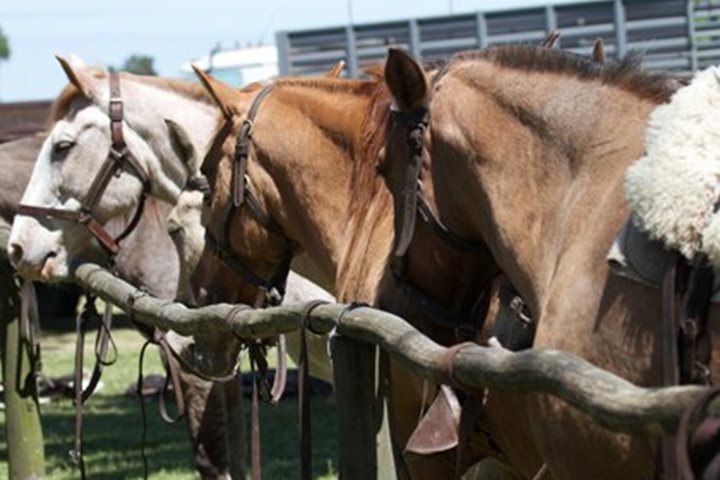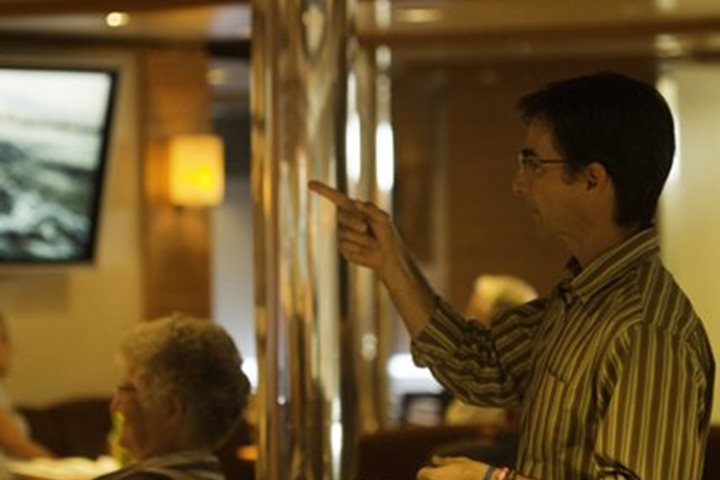We experienced a very relaxing morning at sea, which allowed us to recuperate from the past two or three days of excursions in Trinidad and Tobago. Because of our late departure last night from Port of Spain, Trinidad, we decided to wait until this morning before conducting our Lifeboat Muster exercise. This also gave us a chance to introduce the full compliment of Lindblad Expeditions staff naturalists and National Geographic lecturers and photographers. There wasn’t a lot of marine life to be seen this morning, apart from a few bottlenose dolphins, flying fish, a magnificent frigatebird, and a lone masked booby.
What we did see in abundance, however, were oil rigs dotting the relatively shallow and calm seas off the coast of Venezuela. Today, Venezuela is one of the most important oil-producing countries in the world, and this is also the most important aspect of its national economy. In the late morning, we suddenly encountered greenish tan-colored water that gave evidence we were approaching the mouth of the Orinoco River. The silt-laden fresh water outflow from the river does not immediately mix with the Caribbean Sea’s salt water and the surface meeting line of the two different densities of water (fresh water versus salt water) was very obvious.
As the day wore on, the water we were sailing in got muddier and muddier and as we closed in on the river mouth itself, many more species were observed, including various land birds, shore birds, and terns. We also noticed trees, logs, and aquatic plants, such as water hyacinths, that had floated downstream and were well on their way out into the ocean. By mid-afternoon, we picked up our river pilot somewhere within the long excavated channel leading into the Orinoco River. Soon, the magnificent tropical rain forest could be discerned on either side of the ship, first by binoculars and later by one’s naked eyes. The late afternoon clouds were very impressive, and we could pick out huge cumulo-nimbus clouds forming into thunderheads far away over land.
As our vessel came closer to the eastern shoreline, we could see it presented us with an impenetrable wall of greenery. This flooded edge of the forest is composed of water-resistant trees and all sorts of water plants. It was surprising to suddenly see river people appear occasionally from out of nowhere, it seemed, in small dugout canoes in order to wave to us and ride over our wake. Farther upstream, we began seeing a few widely scattered stilt houses along the forest edge. There were also inviting little tributaries that led into the dense tropical rain forest, which seemed to be beckoning to us. Some people would look at all this and think it something of a “Green Hell,” while others, such as us Lindblad Expeditions naturalists and guests, see it as a kind of “Green Heaven.”
We anchored around sunset near the mouth of a tributary called Rio Araturi, and immediately spotted some red howler monkeys in the tree tops. Another wildlife highlight here, just before dusk, was the sighting of a small flock of blue and gold macaws. This looked like an ideal place to conduct a night expedition.
So, after an early buffet dinner, about half our compliment of guests opted to go out with us on a night excursion. Everything really looks different in the dark. It was great fun to explore along the jungle’s edge, using powerful handheld spotlights with which to search for the eyeshine of creatures in the trees and bushes. Several interesting animals were spotted, including a couple unidentified mammals in trees, bats, a tree boa, various frogs, a big water spider, and more.
Viewing the vegetation up close was also interesting, and we pushed our Zodiacs deep into some narrow, little tributaries where we had to maneuver through brush and duck under overhanging vines and branches. The waning moon, which was just a couple days past its full stage, rose during our venture and gave us some extra light to help us find our way around the river system. It was a near perfect excursion…both adventurous and fun.







